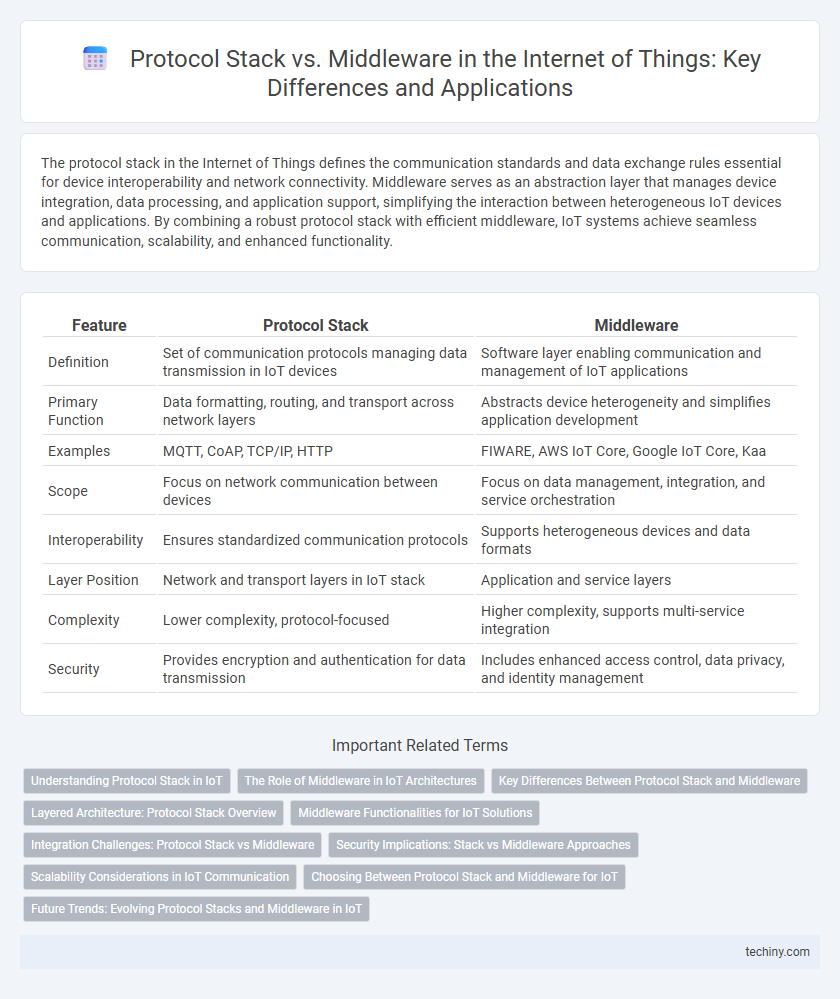The protocol stack in the Internet of Things defines the communication standards and data exchange rules essential for device interoperability and network connectivity. Middleware serves as an abstraction layer that manages device integration, data processing, and application support, simplifying the interaction between heterogeneous IoT devices and applications. By combining a robust protocol stack with efficient middleware, IoT systems achieve seamless communication, scalability, and enhanced functionality.
Table of Comparison
| Feature | Protocol Stack | Middleware |
|---|---|---|
| Definition | Set of communication protocols managing data transmission in IoT devices | Software layer enabling communication and management of IoT applications |
| Primary Function | Data formatting, routing, and transport across network layers | Abstracts device heterogeneity and simplifies application development |
| Examples | MQTT, CoAP, TCP/IP, HTTP | FIWARE, AWS IoT Core, Google IoT Core, Kaa |
| Scope | Focus on network communication between devices | Focus on data management, integration, and service orchestration |
| Interoperability | Ensures standardized communication protocols | Supports heterogeneous devices and data formats |
| Layer Position | Network and transport layers in IoT stack | Application and service layers |
| Complexity | Lower complexity, protocol-focused | Higher complexity, supports multi-service integration |
| Security | Provides encryption and authentication for data transmission | Includes enhanced access control, data privacy, and identity management |
Understanding Protocol Stack in IoT
The protocol stack in IoT defines a layered architecture that ensures effective communication between devices, encompassing physical, data link, network, transport, and application layers. It standardizes data transmission, addressing interoperability, security, and reliability challenges in heterogeneous IoT environments. Understanding the protocol stack is crucial for designing scalable and efficient IoT systems that seamlessly integrate diverse devices and networks.
The Role of Middleware in IoT Architectures
Middleware in IoT architectures acts as an intermediary layer that simplifies communication and data management between diverse devices and applications, enabling seamless interoperability across heterogeneous networks. It abstracts hardware and protocol complexities, providing standardized APIs and services for device management, data processing, and security. This facilitation enhances scalability, flexibility, and real-time responsiveness essential for effective IoT deployments compared to relying solely on protocol stack implementations.
Key Differences Between Protocol Stack and Middleware
Protocol stack in Internet of Things (IoT) refers to a set of communication protocols that manage data exchange across devices, ensuring interoperability and network functionality. Middleware acts as an abstraction layer that facilitates application development by providing services such as data management, device integration, and security without directly handling lower-level network communications. Key differences include protocol stack's focus on communication standards and data transmission efficiency, while middleware prioritizes simplifying development, managing heterogeneous devices, and enabling scalability in IoT ecosystems.
Layered Architecture: Protocol Stack Overview
The protocol stack in the Internet of Things (IoT) consists of multiple layers, each responsible for specific communication functions, including physical connectivity, data link management, network routing, transport reliability, and application-specific services. Middleware operates above this stack, providing abstraction, device management, and seamless data integration across heterogeneous IoT devices and protocols. Understanding the layered architecture of protocol stacks is essential for optimizing IoT communication efficiency and interoperability.
Middleware Functionalities for IoT Solutions
Middleware in IoT solutions functions as a crucial software layer that facilitates seamless communication, data management, and device coordination across heterogeneous network protocols. It abstracts the underlying protocol stack complexities, providing essential services such as device discovery, data aggregation, security enforcement, and real-time analytics. By offering interoperability and scalability, middleware enables efficient integration of diverse IoT devices and applications, ensuring robust and flexible IoT ecosystems.
Integration Challenges: Protocol Stack vs Middleware
Integration challenges in the Internet of Things often arise from the differences between protocol stack and middleware approaches. Protocol stacks require seamless communication across various network layers and standardization of diverse IoT devices, which can be complicated by heterogeneous hardware and inconsistent data formats. Middleware solutions tackle these integration issues by abstracting underlying protocols and providing unified interfaces for data management and device interoperability, yet they must address scalability and security concerns to ensure robust IoT ecosystems.
Security Implications: Stack vs Middleware Approaches
The protocol stack in IoT focuses on securing data transmission through layered encryption, authentication, and network access control, ensuring end-to-end communication integrity. Middleware addresses security by providing centralized policy enforcement, data filtering, and secure access management across heterogeneous devices. Combining protocol stack and middleware approaches enhances holistic IoT security, mitigating risks from communication vulnerabilities and unauthorized data access.
Scalability Considerations in IoT Communication
The protocol stack in IoT ensures scalability by supporting standardized communication layers that facilitate device interoperability and efficient data exchange across heterogeneous networks. Middleware enhances scalability by abstracting underlying protocols and managing resources dynamically, enabling seamless integration of new devices and services without disrupting existing systems. Combining protocol stack robustness with middleware flexibility optimizes large-scale IoT deployments, ensuring scalable, reliable communication.
Choosing Between Protocol Stack and Middleware for IoT
Choosing between protocol stack and middleware for IoT depends on the specific application requirements and system complexity. Protocol stacks provide low-level communication standards essential for device interoperability, while middleware offers higher-level abstraction, enabling easier integration and management of heterogeneous devices. Prioritizing a protocol stack ensures robust network connectivity, whereas middleware facilitates scalability and flexible service orchestration in IoT ecosystems.
Future Trends: Evolving Protocol Stacks and Middleware in IoT
Future trends in IoT highlight evolving protocol stacks that support enhanced interoperability, scalability, and security across heterogeneous devices and networks. Middleware architectures are advancing to incorporate AI-driven analytics, real-time data processing, and adaptive communication management, enabling seamless integration and orchestration of diverse IoT ecosystems. These innovations collectively drive more efficient, intelligent, and resilient IoT deployments in smart cities, healthcare, and industrial automation.
Protocol stack vs Middleware Infographic

 techiny.com
techiny.com